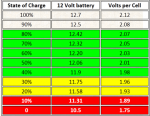Fletchxj
All Things Overlanding
Hey everybody,
Go easy on me as I've had some experience running basic electronics for car stereos over the years, but I'm just now getting into heavier power applications. I've been searching all over this forum and others as well as watching Youtube videos and rather than getting a really clear answer, I find myself more confused. Hence why I'm posting this and risking being flamed, .
.
Any ways, I bought this fridge/freezer a few days ago after taking a 4 day trip with some friends. The benefits for my trips seem pretty obvious and I'd like to keep it, but since purchasing it, I've also learned that my standard starter battery is insufficient to power the fridge for long (duh). I've now come to realize that my friend was using an AGM battery to run his fridge. Which, now that I've done some research, makes perfect sense. So, I'm at a cross road. I'm about $300 in for the fridge and still able to return it to Amazon. Or, I could go with a dual battery set up that solves the fridge problem and gives me some peace of mind regarding long distance solo trips.
Here are the questions I can't seem to find answers to:

Go easy on me as I've had some experience running basic electronics for car stereos over the years, but I'm just now getting into heavier power applications. I've been searching all over this forum and others as well as watching Youtube videos and rather than getting a really clear answer, I find myself more confused. Hence why I'm posting this and risking being flamed,
Any ways, I bought this fridge/freezer a few days ago after taking a 4 day trip with some friends. The benefits for my trips seem pretty obvious and I'd like to keep it, but since purchasing it, I've also learned that my standard starter battery is insufficient to power the fridge for long (duh). I've now come to realize that my friend was using an AGM battery to run his fridge. Which, now that I've done some research, makes perfect sense. So, I'm at a cross road. I'm about $300 in for the fridge and still able to return it to Amazon. Or, I could go with a dual battery set up that solves the fridge problem and gives me some peace of mind regarding long distance solo trips.
Here are the questions I can't seem to find answers to:
- I heard in a Youtube video that I watched that you would have difficulty charging an AGM battery in conjunction with a standard starting battery. Something about them being different so it wouldn't ever fully charge the AGM battery, leading to shorter life and/or failure. Is this true? I was thinking of building my own battery isolator as shown in this thread: LINK.
- Second, the whole "group" thing on the batteries is getting me. I understand that Group 31 are larger than group 24 for example, but I'm not sure whether I'd be able to run the fridge for more than 12 hours on a group 24 vs. 31. I guess what I'm wondering about is capacity based on group size (and whether I can even charge a smaller group AGM battery with the above dual battery isolation and my standard starter battery). For example, 12 volt group 24 batteries are around $100-125. But a Group 31 is around $200-$350. I'm just wondering if a Group 24 would be sufficient to keep a fridge running overnight while saving me the cost since I'm not trying to run a ton of accessories. I'm sorry if these are basic questions, but as you can probably tell, I've done some research and it's just made things worse, haha.
- Alternatively to all this, I guess that another alternative would be just to replace my primary battery with an AGM battery and possibly add a solar charger for peace of mind? Something like THIS?


